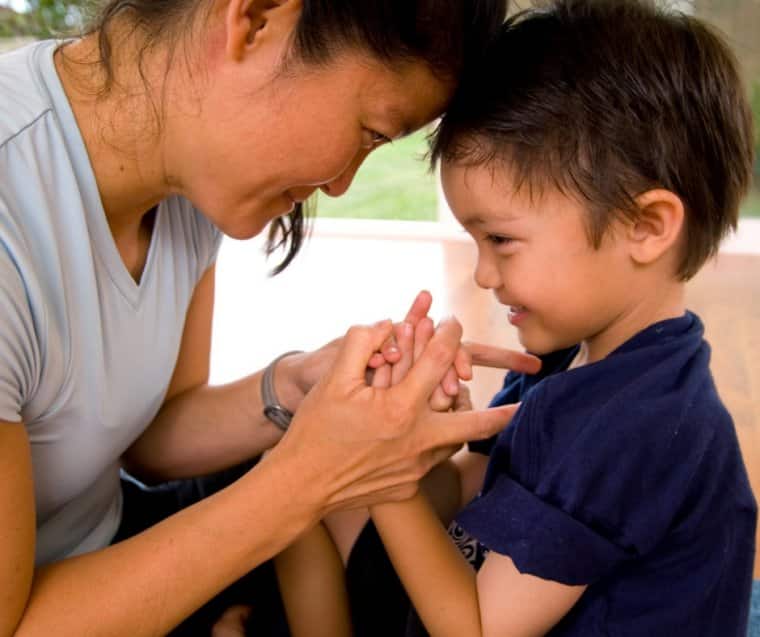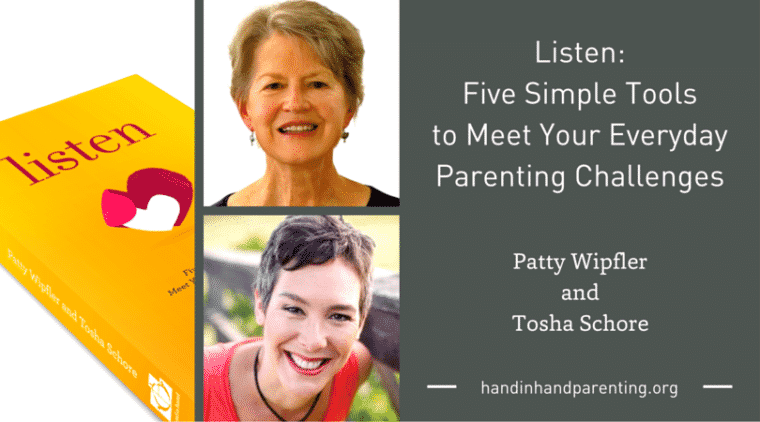A Guest Article by Tosha Schore
If you Google “peaceful parenting” you’ll get 8,150,000 starting points for your journey in a mere .58 seconds.
But then what?
If you’re anything like me, that long list of options feels more like another burden than any sort of help. One more thing to add to your todo list.
The thing is, peaceful parenting is much simpler than we make it out to be.
All you really have to do is connect through those daily run-ins.
Here are a few tips to get you started:
1) Be silly.
When your 10-year-old walks in the door from school, throws her backpack down on the floor, plops herself into a chair and demands you make her a snack, you feel like towering over her and demanding right back that she pick up her stuff right now and NOT TALK TO YOU IN THAT TONE OF VOICE. Together, you spiral downward, the distance between you growing.
 But if instead of running on emotion, you spin around like a magician ready to stun his audience and flick your fingers towards your girl saying, “Poof! You’re a snack!”, she stops, stunned. Your silliness is so unexpected that after a couple of “poofs” you’re both giggling, connected. She asks politely for a snack and cooperates with a smile when you ask that she pick up her backpack while you prepare some food.
But if instead of running on emotion, you spin around like a magician ready to stun his audience and flick your fingers towards your girl saying, “Poof! You’re a snack!”, she stops, stunned. Your silliness is so unexpected that after a couple of “poofs” you’re both giggling, connected. She asks politely for a snack and cooperates with a smile when you ask that she pick up her backpack while you prepare some food.
Moving toward your child playfully like this, removing yourself from the powerful, in-charge roll and following the laughter is called Playlistening. But really, you’re just connecting.
2) Spend one-on-one time together (without your smartphone).
 Have you ever been running late for a meeting and found it impossible to get out the front door due to a 30 lb child suctioned onto your leg like an octopus? You try to shake him off, only to find yourself grabbing your pants in an attempt to keep from mooning the babysitter. The kid sticks. And his whine turns to full-blown panic. Your attention is on the clock, and your patience is waning. In the end, you muster the physical strength to peel him off your leg and run out the door, shutting it quickly behind you. Phew! You’re out. But as you get in the car and pull away from the curb, the warm tears stream down your cheeks. Your heart breaks for your sweet boy.
Have you ever been running late for a meeting and found it impossible to get out the front door due to a 30 lb child suctioned onto your leg like an octopus? You try to shake him off, only to find yourself grabbing your pants in an attempt to keep from mooning the babysitter. The kid sticks. And his whine turns to full-blown panic. Your attention is on the clock, and your patience is waning. In the end, you muster the physical strength to peel him off your leg and run out the door, shutting it quickly behind you. Phew! You’re out. But as you get in the car and pull away from the curb, the warm tears stream down your cheeks. Your heart breaks for your sweet boy.
But there’s another way! If you know that separations are difficult for your child, plan a few minutes of one-on-one time with him before you’re due to leave. Tell him beforehand, so that he has time to consider what he’d like to do with you. When the time comes, set a timer for five to ten minutes, put all distractions aside, and say, “I’ve got ten minutes, all for you. We can do anything you’d like!” Make sure your time together is uninterrupted and child-led, and that your eyes, ears and heart are all on your child. Do this regularly before you head out, and you’ll see your octopus morph into something more like a puppy dog, perhaps looking at you longingly when you leave, but happy while you’re away, and excited to see that at the end of the day you come home. Because this time is like no other time you spend together, it’s called Special Time. But really, you’re just connecting.
3) Set limits lovingly, and continue to show your love when your child fights the limits you’ve set.
It’s a mistake to confound peaceful parenting with permissive parenting, as children need limits to thrive. Any time you notice your little one rigid about having something be just so, understand it as a request for a limit.
Have you ever found yourself, at 25 or 35 or 45, in an argument with your four-year-old over a cookie? She wants one, but you’ve decided that tonight a cookie just doesn’t make sense. You say “No.” She says “Yes.” You say “NO!” She says “YES! I WANT A COOKIE!” The decibels climb, and your anger right along with them. You pull out the guns. “If you calm down, I’ll give you two cookies tomorrow.” “I WANT A COOKIE!” You pull out the big guns. “Quiet right now, or I’ll send you to your room!” Tears. Separation. Anger. Guilt.
But if we think of limits as gifts we give our children to help them move beyond their upsets and fears and towards a place where they can, for example, accept “no” as an answer, then we can set limits lovingly.
“No cookie tonight, sweetie.”
“I WANT A COOKIE!”
“No cookie tonight, sweetie.”
“I WANT A COOKIE!”
“No cookie tonight, sweetie.”
“I WANT A COOKIE!”
Contrary to what we are conditioned to believe, the storm of the disappointment and anger, whether it takes form as tears or a tantrum, is the sound of our child healing. As the feelings spill out, ugly as they may be, she regains her ability to think clearly and cooperate more easily. This is good.
When we take a moment to consider whether or not a limit is necessary and then set limits with a warm tone of voice and allow space for our child’s upset about our decision, the anger and disappointment pour out, and she feels just fine about not getting a cookie. After all, she’s getting the biggest gift of all – us! This is what Setting Limits lovingly and then Staylistening to an upset child looks like. Really, they’re just another couple of ways to connect.
4) Stay connected yourself
 If you’ve read this far and you’re thinking to yourself, “Nice ideas, but when my child disobeys/whines/etc., I don’t have the peace of mind to remember a thing or keep my cool!”, then you can bet that the weight of the hard work of parenting without nearly enough support has hindered your ability to parent peacefully. Whether you try any or all of the ideas above, you will likely need support. And you deserve it!
If you’ve read this far and you’re thinking to yourself, “Nice ideas, but when my child disobeys/whines/etc., I don’t have the peace of mind to remember a thing or keep my cool!”, then you can bet that the weight of the hard work of parenting without nearly enough support has hindered your ability to parent peacefully. Whether you try any or all of the ideas above, you will likely need support. And you deserve it!
Moving away from old parenting habits and adopting new, more peaceful ones, takes a commitment to care for ourselves. We must take a good look at the places where we get triggered and realize that it is our responsibility to heal and shift our behaviors toward our child. When you’re ready, a great way to start is by finding a friend to listen to you without offering advice. Set a timer for five or ten minutes and have them just listen to you. Ask them not to say a thing – to simply pay attention, not judge, and trust that you will find a way through your struggle. When the timer rings, return the favor. Listening to one another in this particular way is called a Listening Partnership.
Bottom line? It’s just connecting with another human being.
So, if remembering these stories and the details of these simple parenting tools don’t feel much easier than navigating 8,150,000 articles on the internet, just remember – if nothing else – to listen.
Listen to your upset child doing their best to show you they need help.
Listen to your heart and your deep love for your child.
And listen to your good mind, as it churns options for how to move through the messy reality of parenting, peacefully.
The bottom line? Just connect.
Meet the Instructor
Tosha Schore, M.A., is a Hand in Hand Trainer, parent coach, and writer. She is the co-author of “Listen: Five Simple Tools to Meet Your Everyday Parenting Challenges.” Tosha is the mother of three boys and an advocate for boys and their families worldwide. She supports parents online, offering courses on raising boys & listening partnerships for moms and dads, as well as personalized parent coaching. She is also a gifted speaker and retreat leader. You can learn more about Tosha and her parenting services at www.toshaschore.com and on her Facebook page, Tosha Schore, Your Partner in Parenting.
Listen to a sample of Tosha's book Listen: Five Tools to Meet Your Everyday Parenting Challenges

